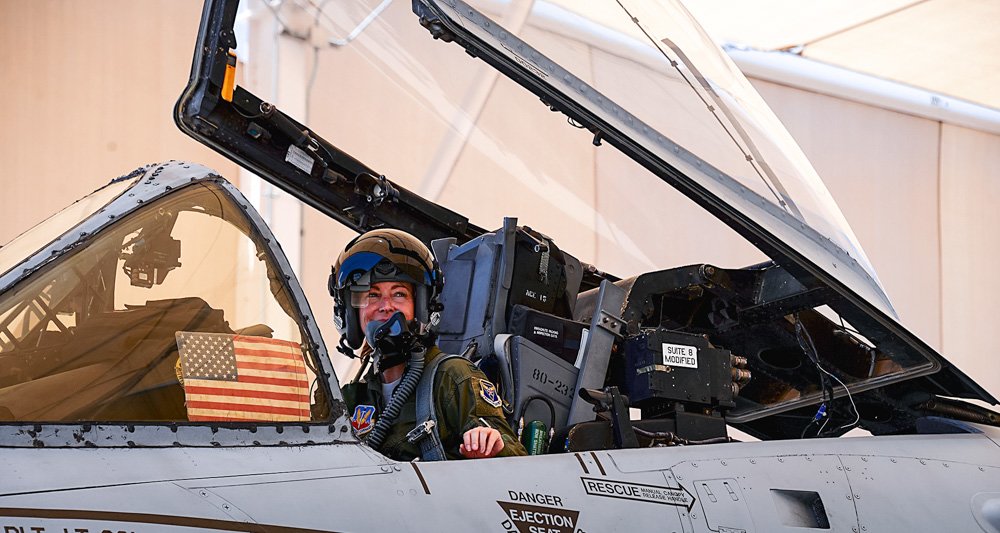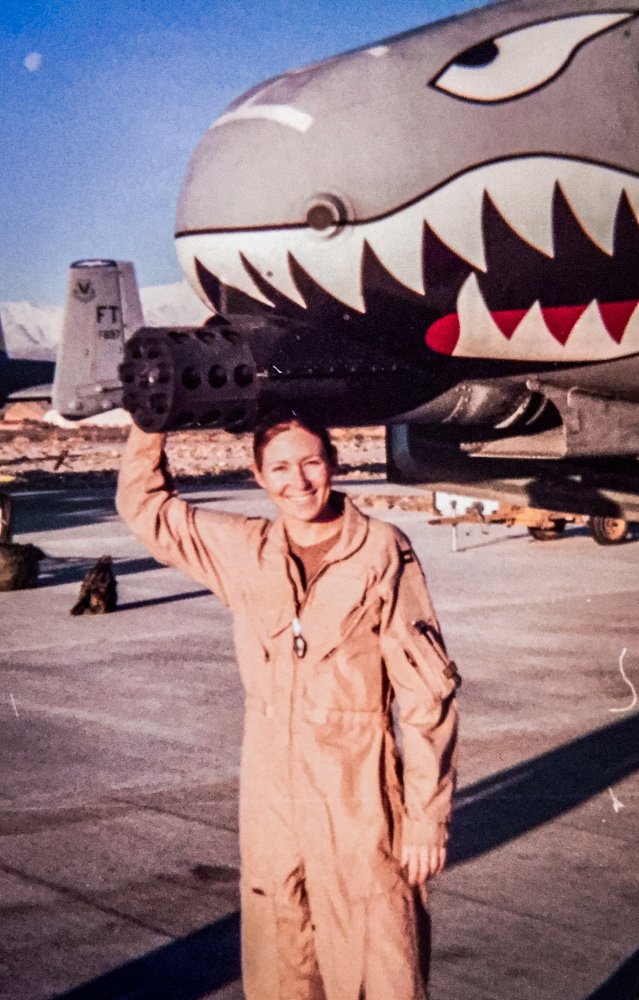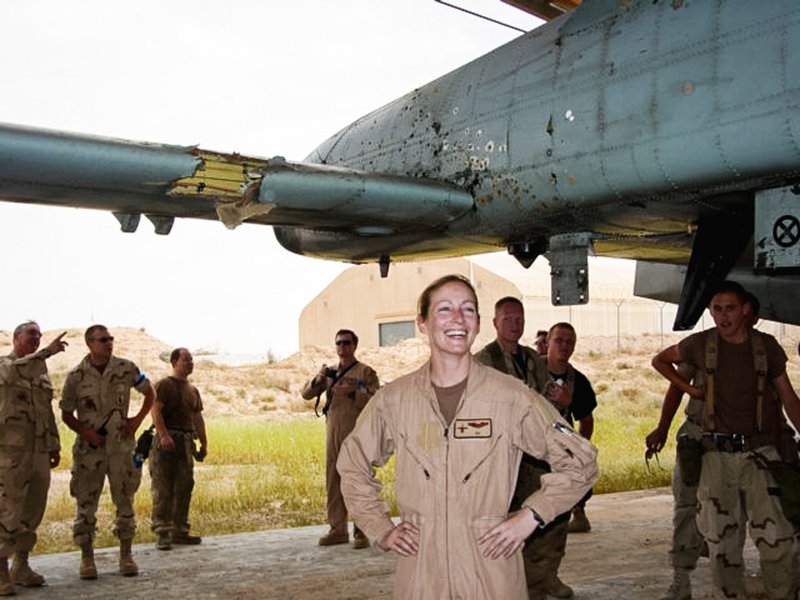
Kim "KC" Campbell sits in the cockpit of an A-10. Photo courtesy of Kim Campbell.
Kim Campbell is not your average Air Force pilot. In fact, there’s nothing average about her. The year Campbell entered the Air Force Academy — 1993 — was the first year the Air Force allowed females to become fighter pilots. Thirty years later, only 20% of all Air Force pilots are female.
Campbell joined the 75th Fighter Squadron as an A-10 pilot in 2000. At that time, there were only 43 female fighter pilots in the Air Force, just more than 1% of the entire fighter pilot force; today, that percentage has roughly doubled.
However, her journey to becoming a pilot began many years earlier.
“When I was in fifth grade, I decided I wanted to be an astronaut,” Campbell said. “I remember watching the launch of the space shuttle Challenger in 1986. At that moment, there was the thrill and excitement of the launch and then the devastation that played out.
“I realized that there was something I connected with in terms of knowing that the astronauts died doing something they believed in, something bigger and more important than themselves.”
Ten-year-old Campbell decided the best way to reach her goal of being an astronaut was to first attend the Air Force Academy and become a fighter pilot.
“I had no idea [when I made this plan] that women weren’t actually allowed to fly fighters,” Campbell said. “My parents never told me that.”
“They could have told me that it wasn’t possible,” she continued, “that women weren't allowed to be fighter pilots and that it would be a long, hard road to go against the rules and norms of the time. Instead, they encouraged me to pursue my goals and dreams. They told me to work hard and go after what I wanted.”
Fast forward 15 years, and Campbell graduated from the Air Force Academy, was selected for a pilot slot, went to pilot training for a year, and then joined the 75th Fighter Squadron as an A-10 pilot.

Kim Campbell poses with classmates at the US Air Force Academy. Photo courtesy of Kim Campbell.
The job of an A-10 pilot is unique with regard to the rest of the Air Force fleet. A-10s are designed to provide close air support to friendly ground troops by attacking armored vehicles, tanks, and other enemy ground forces. This is the only aircraft designed solely for CAS in the Air Force.
“I loved the mission of the A-10,” Campbell said. “The mission of close air support and supporting our troops on the ground, knowing that I could make a difference — I enjoyed that.”
“I started flying the A-10 before 9/11, so needless to say, I flew missions in Afghanistan and Iraq multiple times from when I was a young wingman to being the flight lead and instructor,” Campbell said. “In each instance, it’s all about preparation, training, and being ready for contingencies.”
Campbell has 1,800 hours of flying time, including 375 hours on combat flights for 100 combat missions, but one story stands out as her defining moment as a pilot.

Kim Campbell in front of an A-10 Warthog. Photo courtesy of Kim Campbell.
On April 7, 2003, Campbell was doing what A-10 pilots are meant to do — providing close air support for soldiers on the ground near Baghdad, Iraq. Then her plane was struck by a surface-to-air missile.
“This is the kind of mission we trained for,” Campbell said. “Our troops on the ground were taking fire, so we were going to do everything we could to get in there and help them out.
“We had to take some additional risks. Due to the weather conditions, we had to fly lower than normal to support the frontline troops properly.”
As Campbell came off her last pass, the plane came under fire and she immediately lost control.
“I thought about ejecting, but that didn’t seem like a great idea over Baghdad,” Campbell said. “Thankfully, I got the jet into our backup emergency system and started the trip home. Granted, that was still an hour-long flight.”
Campbell couldn’t assess the damage from inside the cockpit, so she relied on others in her team.

Kim Campbell in front of an A-10 Warthog with flight gear. Photo courtesy of Kim Campbell.
“It wasn’t until my flight lead filled me in that I knew what I was flying with,” she said. “There were hundreds of holes in the fuselage and tail section and a hole about the size of a football in the back horizontal stabilizers. The A-10 was designed to take damage like that, so I was able to fly the hour home, and I made the decision to land it in the hopes that the plane would be able to be flown again.”
Due to the extent of the damage, Campbell’s plane never flew again. But because she chose to land it instead of ejecting, maintenance was able to repurpose much of the plane for other aircraft repairs.
“I was impressed,” Lt. Col. Mike Millen, chief of safety for the 332nd Air Expeditionary Wing, told the Aviation Geek Club in 2019. “Kim landed that jet with no hydraulics better than I land the A-10 daily with all systems operational.”
Campbell returned to flying the next day, supporting a search and rescue mission to locate a downed A-10 pilot near Baghdad.

An A-10 Warthog prepares to take off from Al Asad Air Base to provide close air support to ground troops in Iraq, Nov. 30, 1999. The 438th Air Expeditionary Group A-10 jets perform 10 sorties daily, 900 in the previous four months. US Air Force photo by Master Sgt. Cecilio Ricardo.
“I never really had time to think about the fact that I was going back to Baghdad, where just the day before, I had escaped a possible shoot down,” she said. “In my mind, the only thing that I could think about was that I had a job to do. I knew the search and rescue alert crews were there for me the day before, and I would do the same for this pilot.”
For her skillful flying and determination in carrying out the mission, Campbell was awarded the Distinguished Flying Cross. Part of the citation reads, “Captain Campbell's aviation prowess and coolness under pressure directly contributed to the successful completion of the critical mission and recovery of a valuable combat aircraft. The outstanding heroism and selfless devotion to duty displayed by Captain Campbell reflect great credit upon herself and the United States Air Force.”
After retiring from the Air Force in 2021, Campbell transitioned to life as a motivational and keynote speaker.
“Credibility is the No. 1 thing,” Campbell said. “Not just as a female, but especially as a female fighter pilot — credibility, humility, and approachability are important traits. Being a leader in a male-dominated community makes connecting and creating trust all the more important.

Then-Capt. Kim Campbell stands with her damaged A-10 Thunderbolt II after a 2003 combat mission where she was nearly shot down over Baghdad, Iraq. US Air Force Academy photo.
“Looking back on my career, I realized that none of what I accomplished happened alone. It was all about being part of a team. We supported and encouraged each other; we knew where we fit in the bigger picture and challenged each other. We pushed each other to be at our absolute best, and that whole idea of lifting others allows you to elevate the team's performance. That’s something that’s critical on any team.”
Two years into life as a civilian, Campbell continues to share her story of survival and service while also working to impart the lessons she’s picked up along the way. Her recently published book, Flying in the Face of Fear: A Fighter Pilot’s Lessons on Leading with Courage, shares the principles and strategies she learned in the military and how she found success as a leader.
“I found my purpose and passion in flying and supporting our troops,” Campbell said. “But at some time, that comes to an end. So being able to influence the next generation of leaders at the Air Force Academy was my next calling. I wanted to be able to continue that outside of the military.”
Campbell’s story is now on permanent display at the Smithsonian. The Air & Space Museum has a piece of the plane from her historic flight for every visitor.
“There are so many skills and lessons learned in the military that are applicable outside the cockpit,” Campbell said. “To be able to share those stories and help others develop and grow has become my new purpose.”
Read Next: Pilot Who Landed A-10 After Catastrophic Gun Failure Earns Kolligian Trophy, Makes History

Lauren Warner is the managing editor of the BRCC Blog. She's only slightly connected to the military community, growing up as an Army brat before serving in the Army herself as a public affairs specialist, then becoming an Army spouse and caregiver. With degrees in English, journalism, and a master's in marketing, to say that she enjoys reading and writing might be an understatement. She spends her free time drinking too much coffee and going on adventures with her husband and three dogs (yes, they're all rescues).
BRCC and Bad Moon Print Press team up for an exclusive, limited-edition T-shirt design!
BRCC partners with Team Room Design for an exclusive T-shirt release!
Thirty Seconds Out has partnered with BRCC for an exclusive shirt design invoking the God of Winter.
Lucas O'Hara of Grizzly Forge has teamed up with BRCC for a badass, exclusive Shirt Club T-shirt design featuring his most popular knife and tiomahawk.
Coffee or Die sits down with one of the graphic designers behind Black Rifle Coffee's signature look and vibe.
Biden will award the Medal of Honor to a Vietnam War Army helicopter pilot who risked his life to save a reconnaissance team from almost certain death.
Ever wonder how much Jack Mandaville would f*ck sh*t up if he went back in time? The American Revolution didn't even see him coming.
A nearly 200-year-old West Point time capsule that at first appeared to yield little more than dust contains hidden treasure, the US Military Academy said.












